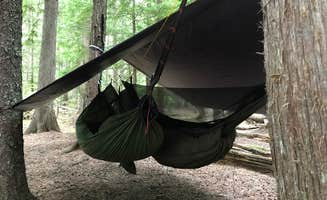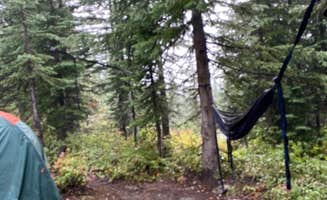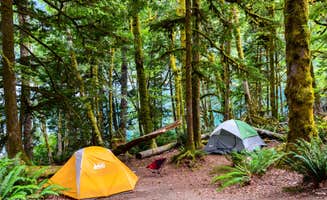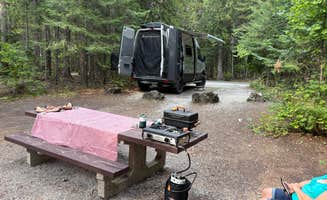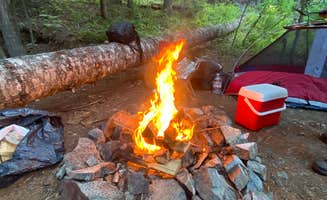Tent camping near Porthill, Idaho centers on the northern Selkirk Mountains region along the Canadian border, where elevations range from 1,800 to 7,000 feet across the camping areas. The region falls within the Kaniksu National Forest, part of the larger Idaho Panhandle National Forests system. Summer temperatures typically reach 75-85°F during the day but can drop to 40-50°F at night even in July, requiring proper gear for temperature fluctuations.
What to do
Hiking to alpine lakes: Beehive Lake provides challenging hiking with significant rewards. "This hike-in lake campground is a true alpine treasure, but be prepared to work for it! The hike to get there is pretty strenuous, with some tough climbs along the way. The trail itself isn't well marked, so you'll want to pay close attention or bring a good map to avoid getting off course," notes Jason S. about Beehive Lake Dispersed.
Kayaking and canoeing: The pristine waters of Upper Priest Lake offer excellent paddling options. Brian L. at Navigation Campground shares, "Nice isolated campground at the North end of Upper Priest Lake. We hiked in from Beaver Creek campground on Priest Lake (9 miles, round trip)... Next time we're going to kayak in."
Fishing opportunities: Most alpine lakes in the region are stocked with trout. Local fishing regulations require an Idaho fishing license. During summer months, fish early morning or evening when temperatures are cooler and fish are more active.
What campers like
Natural isolation: The remote locations around Porthill create genuine wilderness experiences. "I hiked in and had the place to myself," reports Jill S. about Plowboy Campground, adding, "No car access which makes it much quieter and less used. I was there on a hot July weekday and there were only two parties camping, both which had come by canoe."
Waterfront campsites: Many campgrounds offer direct lake access. Megan K. explains about Trapper Creek Campground: "The campsites are lake front and the surrounding area has a lot of rotting trees and ferns. This is a great easygoing backpacking trip suitable for beginners. The trail a through trail!"
Varied accessibility options: The region provides options for different comfort levels. Some sites require substantial hiking while others are more accessible. Roman Nose offers both developed sites and backcountry options, as Meghan B. describes: "The actual campground has 4 designated sites and a group tent area. Trails lead to the lakes from each campsite or from the trailhead parking lot. The first lake is a short, easy walk. The 2nd (Lower) and 3rd (Upper) lakes are a moderate hike."
What you should know
Bear safety requirements: This is grizzly bear habitat and requires proper precautions. Alex P. warns about Solomon Lake Campsite: "No Verizon cell service, very remote, with lots of Grizzly warnings, so proper food storage is required!"
Limited facilities: Most sites have minimal infrastructure. Even developed sites typically offer only vault toilets and fire rings. Navigation Campground features "A vault toilet, a few picnic tables and fire rings, but lots of space among the trees to set up camp," according to Jill S.
Road conditions: Forest service roads can be challenging. Access to Roman Nose features "a long and VERY washboarded" road according to Meghan B., who adds, "If you're not looking to hike, I'm not sure beating up your vehicle for a solid hour on a washboarded dirt road is worth it just for camping here."
Tips for camping with families
Choose appropriate hikes: When tent camping with children in Porthill, select trails matching ability levels. Megan K. recommends Trapper Creek: "This is a great easygoing backpacking trip suitable for beginners. The trail a through trail! Next time I plan to come in at the north end and hike through to the south end after dropping off a car."
Pack extra clothing: Mountain temperature fluctuations require preparation. Nighttime temperatures often drop below 50°F even in summer months, so pack warm sleeping bags and additional layers for children.
Water safety precautions: Alpine lakes are typically very cold year-round. Jason S. describes Beehive Lake: "The alpine lake at the end of the trail is stunning—clear, pristine water surrounded by rugged mountain scenery. It's the kind of place that feels untouched and pure."
Tips from RVers
Limited RV options: Most camping near Porthill focuses on tent camping with few accommodations for larger vehicles. Small trailers and camper vans can access Whitetail Campground in nearby Montana, where Mical M. notes, "Very quiet and beautiful spot. Our site had a nice open meadow and was right next to access to the river. We spent the afternoon with our chairs on the riverbank and dangling our feet in the water."
Dispersed options: Some forest roads have pull-offs suitable for smaller RVs. These lack services but offer more isolation. Research and scout locations in advance as cell service is unreliable throughout the region.
Road preparedness: Forest service roads require high clearance vehicles in many areas. Pack extra supplies including water, as most campgrounds don't provide drinking water.


